Introductory remarks: Paleozoic Foramifera
The fossil record indicates that the very first foraminifera
(with a hard shell) was the unilocular simple agglutinated
Allogromiina, which
evolved into the calcareous agglutinated
Textulariina during the Cambrian. While the Textualariina were a dominant group early in the Paleozoic, the
Fusulinina became dominant later in the Paleozoic
(from the Silurian).The Fusulinina are morphologically larger with compound, microgranular walls and complex internal structure and they constitute much of the Late Paleozoic shallow-marine
limestone seen today (BouDagher-Fadel, 2008).
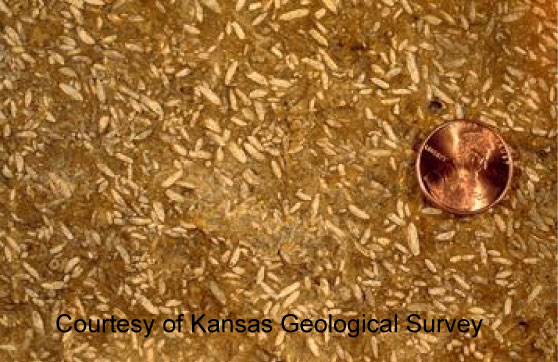
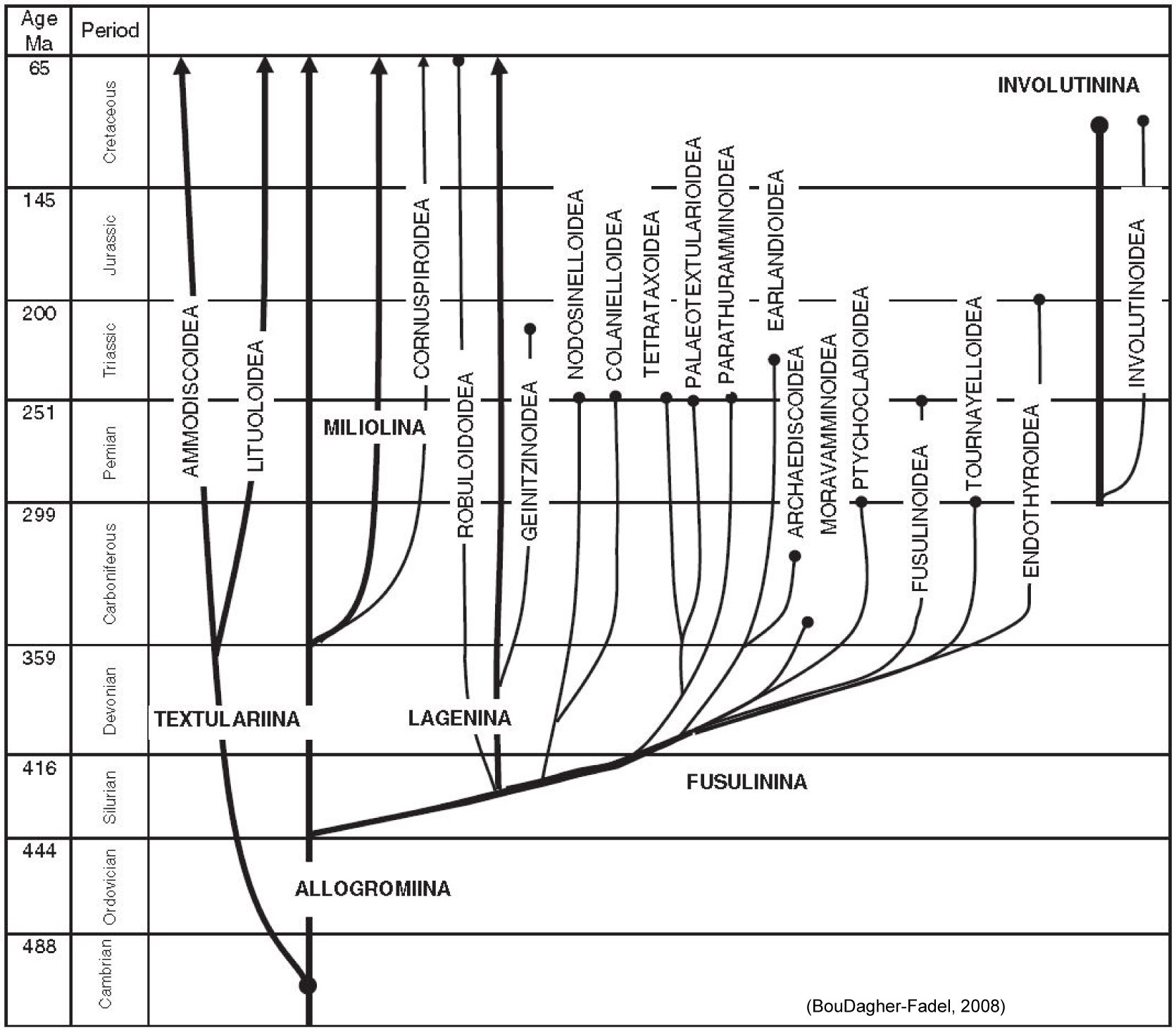
Because of their importance, the main focus of this sub-page is the suborder
Fusulinina. Other suborders we will discuss here are the
Lagenina, which evolved in the Silurian, the
Miliolina and the early
Involutinina. The lagenines, miliolines and involutinines were morphologically
small and primitive throughout the Paleozoic, measuring between 0.4 and 1.3 mm in diameter. The evolution of the Paleozoic larger foraminifera is shown to the left (
BouDagher-Fadel, 2008).
The suborder Fusulinina contains twelve superfamilies and 418 distinct genera (Loeblich and Tappan, 1988), most of which became highly specialized during the latter part of the Paleozoic. Rapid evolution facilitated large and diverse lineages of Fusulinina and they achieved a remarkable size for a single celled organism. By the end of the Permian, some forms of fusuline reached 15 cm in diameter (BouDagher-Fadel, 2008). Despite their dominating presence, complicated structure and large size, they were extinct by the end of the Paleozoic.
Below we present a brief description of each superfamily and family and include a description of select genera beneath each family. For more detailed taxonomic descriptions of all genera, see Loeblich and Tappan (1988) and Rauser-Chernousova et al. (1996). Additionally, please refer to the paper by M. BouDagher-Fadel (2008), from which this page is summarized, and references found there-in, especially regarding the individual descriptions for each family. Also, refer to the Miracle home-page, constructed by Dr. Marcelle K. BouDagher-Fadel of the University College of London (University College of London - MIRACLE).
For a list of key Suborders, Superfamilies and Families that are discussed in the following sections, please see the diagram below (after BouDagher-Fadel, 2008). This diagram, as well as the large diagrams in the following section can be viewed at a larger scale once the shadowbox has been activated by right-clicking on the diagram and opening it in a new tab (Google Chrome) or selecting the View Image function (IE).
SUBORDER FUSULININA
- Test: homogeneously microgranular primary test made of low-magnesium calcite, in which the crystal units have no optical alignment.
- Wall: advanced forms have two or more alignment
- Geologic Range: Silurian to Triassic
Superfamily PARATHURAMMINOIDEA
- Test: unilocular, globular or tubular
- Wall: simple calcareoius microgranular or with granulo-fibrous layers.
- Geologic range: Early Silurian to Permian. Live free or attached.
Family Archaesphaerida
- Test: One or more globular to elongate chambers
- Wall: No aparent aperture
- Geologic range: Late Silurian to Early Permian
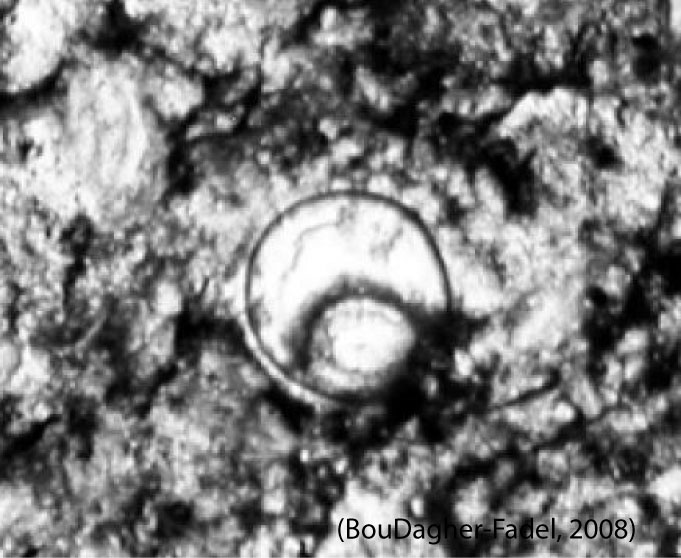 |
Diplosphaerina
Test: Two chambered, with small proloculus enveloped within a larger chamber
Geologic range: Middle Devonian to Tournaisian
|
Family Parathuramminidae
- Test: globular or irregular
- Wall: simple calcareous agglutinated wall with multiple aperture at end of tubular neck
- Geologic range: Late Silurian to Carboniferous
![]() 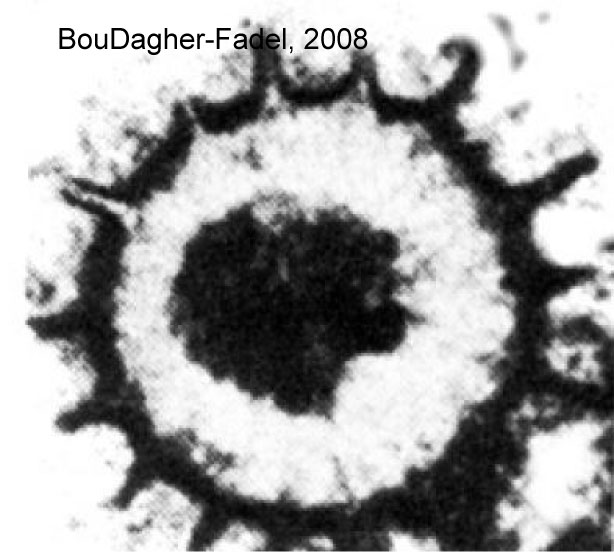 |
Parathurammina
Test: Globular with aperature at ends of numerous tubular protuberances
Geologic range: Late Silurian to Carboniferous
|
Family Chrysothuramminidae
- Test: globular to irregular in outline
- Aperture: at the end of tubular projections
- Geologic range: Middle Devonian to Carboniferous
![]()
|
Chrysothurammina (B)
Test: Single subspherical chamber
Aperture: on a neck-like protrusion.
Geologic range: Middle Devonian to Carboniferous
|
Family Ivanovellidae
- Wall: thick calcareous
wall with two layers; a thin dark compact granular inner layer and a thick grey
radially fibrous outer layer.
- Geologic range: Late
Silurian to early Carboniferous
![]()
|
Elenella (B)
The outer surface has tiny projections;
Aperture: none
Geologic range: Middle Silurian to Carboniferous
|
Family Marginaridae
- Wall: three layered; inner and outer layers are dark and the middle layer is light gray with canals running through it, which form projections outside the wall
- Geologic Range: Middle to Late Devonian
Family Uralinellidae
- Wall: small, unilocular with three layers. The median layer is thick and clear and the outer layers dark.
- Aperture: a multiple apertural neck is projected from the test
- Geologic range: Middle Devonian to Early Carboniferous
|
![]()
|
Sogdianina
Aperture: very prominent apertural necks
Geologic range: Carboniferous
|
Family Auroriidae
- Test: ovate.
- Wall: two layered, a thin inner finely porous dark layer and a thick outer canaliculated dark layer
- Geologic range: Middle to Late Devonian.
|
![]()
|
Auroria
Test: irregularly globular
Geologic range: Middle to late Devonian
|
Family Usloniidae
- Test: globular with no distinct aperture
- Geologic range: Middle Devonian to Early Carboniferous
![]()
|
Parphia
Test: spherical to ovate
Wall: dark and evenly porous
Geologic range: Late Devonian
|
Family Eovolutinidae
- Test: globular
- Wall: microgranular with single distinct aperture
- Geologic range: Late Silurian to Late Devonian
|
![]()
|
Eovolutina
Test: tiny with proloculus completely surrounded by second chamber
Geologic range: Late Silurian to Late Devonian
|
Family Tuberitinidae
- Test: simple, attached, made of one or more globular chambers
- Wall: calcareous, microgranular
- Geologic range:Silurian to Permian
|
![]()
|
Draffania
Test: Flask-shaped tuberitinids
Aperture: at the end of an elongate neck
Geologic range: Tournaisian to Visean
|
|
![]()
|
Eotuberitina
Test: hemispherical with basal disc
Wall: microgranular, coarsely perforate
Geologic range: Middle Devonian to Middle Carboniferous
|
|
![]()
|
Paratuberitina
Test: highly hemispherical with basal disc
Wall: microgranular, coarsely perforate
Geologic range: Carboniferous (Visean to Moscovian)
|
|
![]()
|
Tuberitina
Test: Shows bulbous chambers in an arcuate or straight series
Geologic range: Late Carboniferous to Late Permian
|
|
![]()
|
Tubeporina
Test:hemispherical with basal disc and three-layered wall; a hyaline layer between two microgranular layers
Wall: coarsely perforate
Geologic range: Middle Devonian to Carboniferous
|
Superfamily EARLANDIOIDEA
- Test: free, non-septate with a globular first chamber and a straight tubular second chamber
- Geologic range: Late Silurian to Early Triassic
Family Earlandiidae
- Chamber: single, free
- Geologic range: Late Silurian to Early Triassic
|
![]()
|
Earlandia
Test: free, elongate, composed of globular proloculus followed by an undivided straight tubular chamber
Wall: calcareous microgranular
Geologic range: Late Silurian to Early Triassic
|
Family Pseudoammodiscidae
- Test: small with a simple aperture and globular proloculus followed by planispiral, trochospiral or streptospirally coiled, undivided second chamber
- Geologic range: Devonian to Permian
|
![]()
|
Brunsia
Test: proloculus is followed by an early streptospiral coil and later a planispirally enrolled tubular chamber
Geologic range: Devonian to Carboniferous
|
|
![]()
|
Brunsiella
Test: globular proloculus is followed by undivided second chamber, early whorls streptospiral, later ones planispiral and evolute
Geologic range: Carboniferous to Early Permian
|
Family Pseudolituotubidae
- Test: attached
- Chamber: single enrolled with simple terminal aperture
- Wall: calcareous microgranular
- Geologic range: Early Carboniferous to Late Carboniferous
Superfamily ARCHAEDISCOIDEA
- Test: small, consisting of a proloculus followed by an enrolled chamber
- Wall: one or more layers
- Geologic range: Early Carboniferous to Late Carboniferous
Family Archaediscidae
- Test: discoidal test composed of a proloculus followed by a stretospirally enrolled second chamber
- Wall: dark inner granular layer and a clear radially fibrous or granulo-fibrous outer layer
- Geologic range: Early Carboniferous to Late Carboniferous
![]() 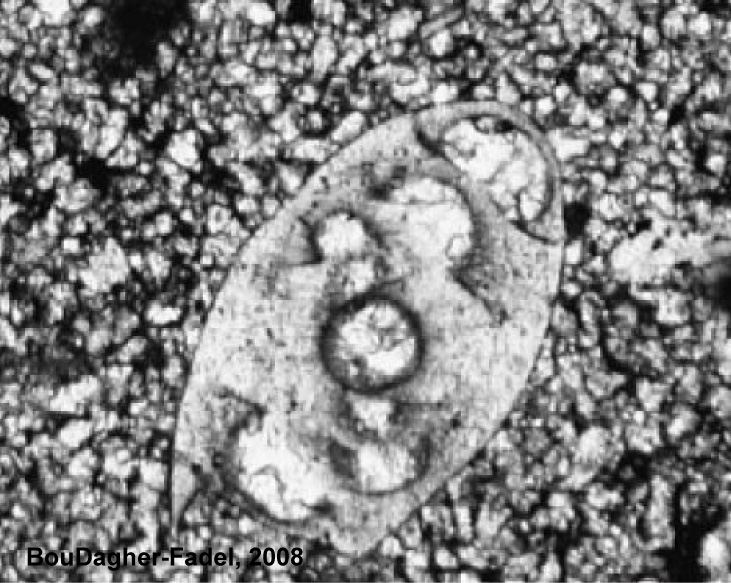 |
Archaediscus
Test: free streptospiral, with an undivided tubular second chamber and thickened wall
Geologic range: Carboniferous
|
![]() 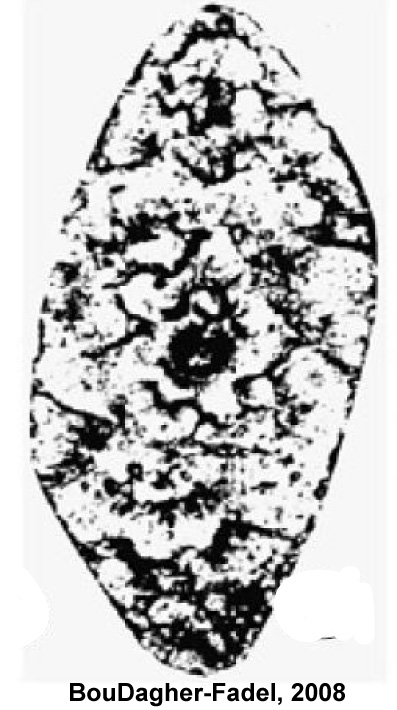 |
Asteroachaediscus
Test: small, lenticular with sigmoidal coiling, stellate and with occluded chamber cavity
Geologic range: Carboniferous
|
![]() 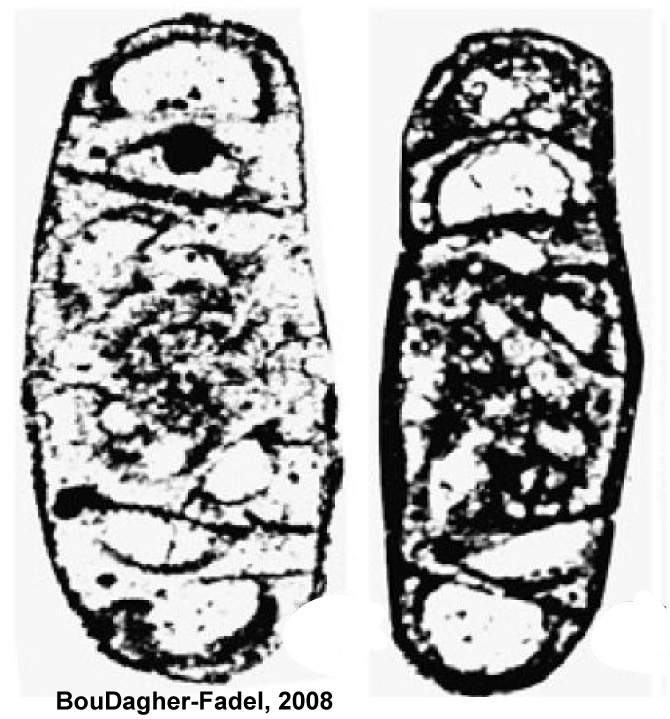 |
hemiarchaediscus
Test: small, discoidal with glomospiral early whorl, later becoming planispiral; chamber lumen remains open
Geologic range: Carboniferous
|
![]() 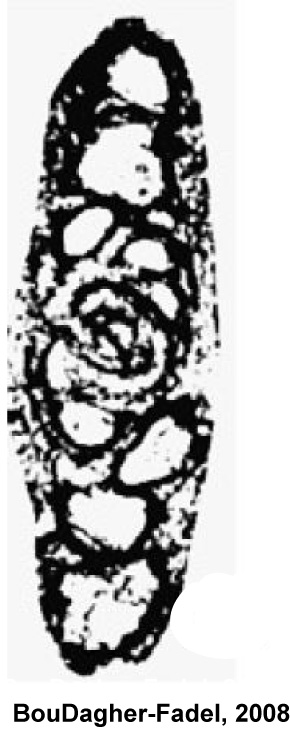 |
Planoarchaediscus
Test: small discoidal with glomospiral early stage, followed by a planispiral adult; chamber lumen remains open
Geologic range: Carboniferous
|
![]() 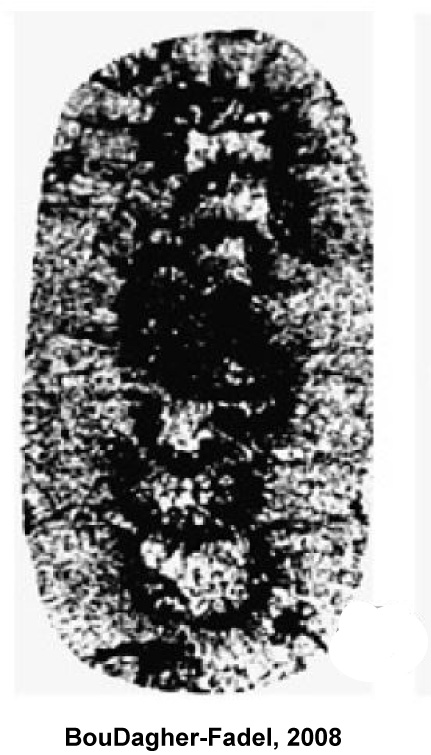 |
Propermodiscus
Test: small, lenticular wtih glomospiral early whorls and a planispiral, involute adult
Geologic range: Carboniferous
|
Family Lasiodiscidae
- Test: discoidal to conical. The radial-fibrous outer layer is mainly concentrated in the umbilical region where it may for pillars, or a series of tubercles on the surface of one side of the test
- Geologic range: Early Carboniferous to Permian
![]() 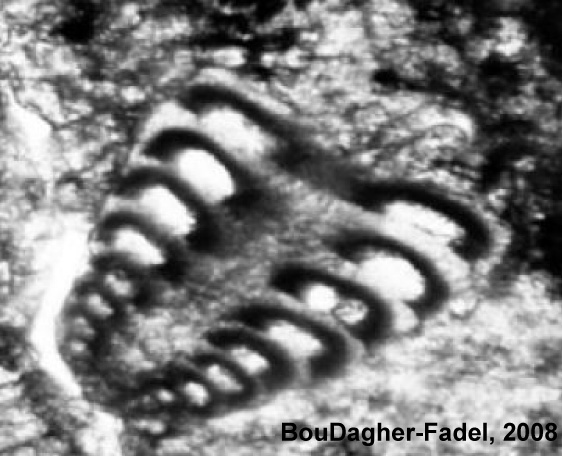 |
Howchinia
Test: conical with septal bridges. The umbilical region is filled with fibrous calcite-forming pillars
Geologic range: Carboniferous
|
Superfamily NODOSINELLOIDA
The Nodosinelloidea evolved from the Parathuramminoidea via the free Moravamminoidea. This evolution of the families is shown graphically below. Please refer to Figure 1 (below) to trace the evolution of the specific family and their genera.
- Test: Free with more than one distinct chamber, partially septate or fully septate
- Wall: simple microgranular, evolving into forms with an extra fibrous inner layer
- Geologic range: Late Silurian to Permian
Family Earlandinitidae
- Test: simple microgranular
- Geologic range: Late Devonian to Late Carboniferous
- The Earlandinitidae evolved from the Caligellidae by becoming elongate uniserial, semiseptate.
- Genera: Earlandiinita. Subseptate with a terminal round aperature; Carboniferous
Family Nodosinellidae
- Test: uniserial test developed in the Late Carboniferous
- Wall: double-layered with an inner fibrous layer and an outer microgranular layer
- Geologic range: late Silurian to Permian
- The Nodosinellidae evolved from the Earlandinidae
- Genera: Nodosinella. Free and fully septate test; Permian
Superfamily COLANIELLAOIDEA
- Test: uniserial and fully septate
- Chamber: strongly overlapping with partitions
- Wall: an outer vitreous layer and an inner granular layer
- Geologic range: Late Devonian to Late Permian
Family Colaniellidae
- Test: strong internal partitions or septa
- Geologic range: Late Devonian to Late Permian
- Genera: Colaniella. Elongate and uniserial, having a calcareous wall with a fibrous structure and a terminal radiate aperture. Late Permian.
Superfamily PTYCHOCLADIOIDEA
- Test: No distinct apertures; attached
- Wall: microgrnular, banded with transverse tubuli
- Geologic range: Late Devonian to Carboniferous
Family Ptychocladiidae
- Test: uniserial and attached
- Geologic range: Late Devonian to Late Carboniferous
- Genera: Ptychocladia. Calcarous microgranular two layered wall with no distinct aperture. Late Pennsylvanian.
Superfamily Palaeotextularioidea
- Test: biserial or uniserial
- Wall: microgranular calcareous with single or multiple aperatures (in later stages)
- Geologic range: Middle Devonian to Permian
Family Semitextulariidae
- Test: biserial, flattened but often becoming monoserial with broad chambers; fully septate
- Geologic range: Devonian to Pennsylvanian
- Genera: Koskinotextularia. Elongate, biserial test with a single layered wall and single aperture in early stages but later becoming cribrate. Early Carboniferous to Late Carboniferous.
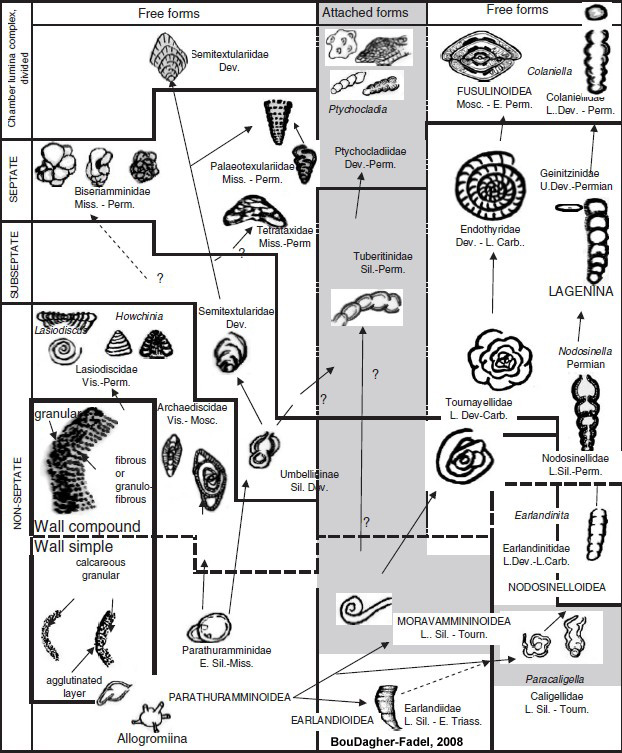
Figure 1. Schematic morphological evolution of the Fusulinina (and Lagenina) from the Allogromiina (BouDagher-Fadel, 2008)
Family Palaeotextulariidae
The palaeotextulariidae evolved from simple agglutinated froms in the Devonian (Cummings, 1956). Please refer to the figure below to trace the evolution of the palaeotextularioidea.
- Test: dark granular calcareous outer wall and inner clear to yellowish 'fibrous' layer with stacks of granules perpendicular to the surface; resembles Textulariidae
- Geologic range: Early Carboniferous to Permian
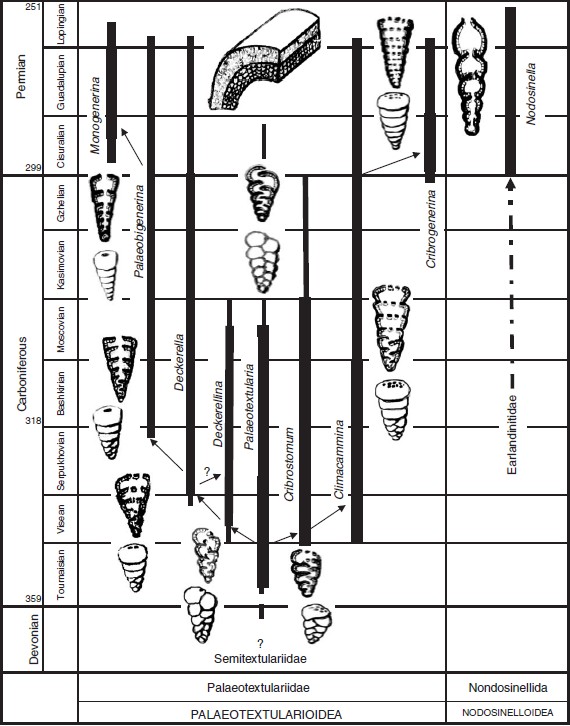
![]() 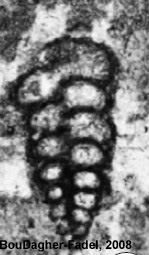 |
Palaeotextularia
Test: biserial
Wall: thick with a low slit (aperture) opening at the base of the final chamber
Geologic range: Carboniferous to Permian
|
![]() 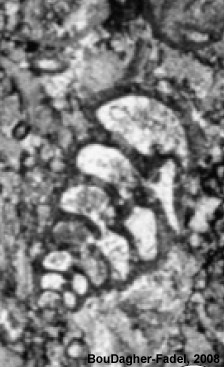 |
Deckerellina
Test: biserial
Aperture: in the early stage is a slow slit but the adult aperture is two parallel slits
Geologic range: Carboniferous
|
![]() 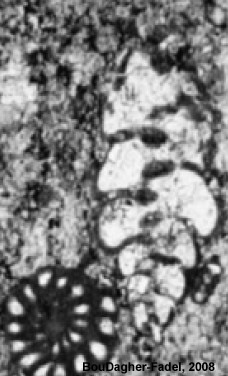 |
Deckerella
Test: biserial in early stage, later uniserial and rectilinear
aperture: a low slit in th eearly stage, later terminal with two parallel selits separated by a a partition
Geologic range: Carboniferous to Permian
|
![]() 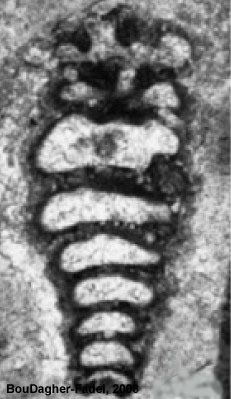 |
Cribrostomum
Test: biserial
aperture: in the early part is basal, in the last two whorls becoming areal, multiple and cribrate
Geologic range: Carboniferous to Permian
|
![]() 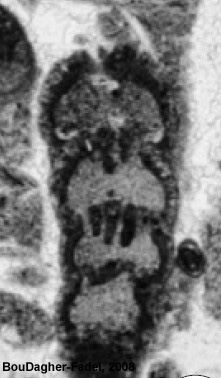 |
Climacammina
Test: biserial followed by a uniserial stage
Aperture: in the early stage is at the base of the last chamber, later becoming areal, multiple and cribrate
Geologic range: Carboniferous to Permian
|
Family Biseriamminidae
- Test: In early stages the test is biserial but transitions to a planar test in later stages
- Wall: microgranular with one or more layers
- Geologic range: Carboniferous to Permian
- Genera: Biseriella. the early stage is tightly coiled and later has an open helicoid spire. Carboniferous to Permian
Superfamily TETRATAXOIDEA
Test: conical with secondary internal partitions
Wall: microgranular with one or two layers
Geologic range: Carboniferous to Permian
Family Tetrataxidae
- Test: conical leaving an open central umbilicus where the chambers are partially overlapping
- Wall: calcareous microgranular and in two layers
- Geologic range: early Carboniferous to Late Carboniferous
![]() 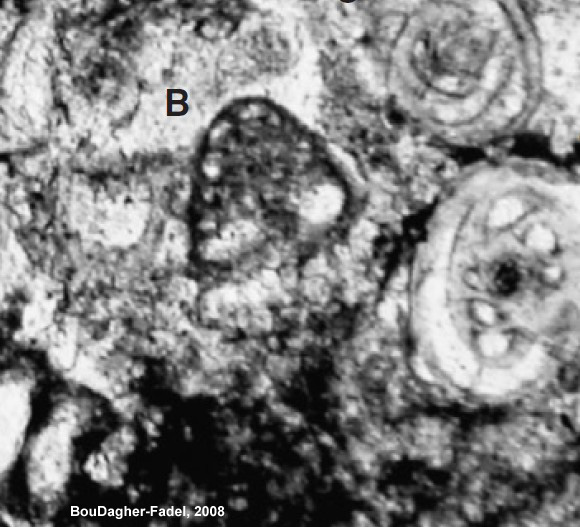 |
Tetrataxis
Test: outer layer dark and microgranular; inner layer is light and fibrous
Geologic range: Carboniferous
|
Family Pseudotaxidae
- Wall: calcareous, microgranular and single layered
- Geologic range: Tournaisian to Bashkirian
- Genera: Vissariotaxis. Conical with trochospirally coiled chambers and wide aperture. Carboniferous.
Family Valvulinellidae
- Test: conical with subdivided chambers
- Wall: single layer, microgranular
- Geologic range: early to late Carboniferous
![]() 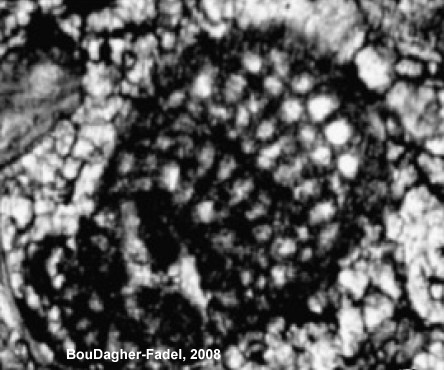 |
Valvulinella
Test: chambers are separated by numerous vertical pillars and one or two horizontal ones
Geologic range: Carboniferous
|
Family Abadehellidae
- Test: Representatives of this family differ from the Valvulinellidae as they have two double-layered walls instead of a single-layered wall
- Geologic range: Late Permian
- Genera: Abadehella. Conical with numerous whorls and subdivided chambers by regularly spaced pillars. Late permian
Superfamily MORAVAMMINOIDEA
- Test: Simple free or attached consisting of a proloculus and a rectinilinear second chamber that was subseptate
- Wall: simple
- Geologic range: Evolved from the Parathuramminoidea in the Silurian but died out in the Early Carboniferous
Family Caligellidae
- Test: attached and subseptate
- Geologic range: Late Silurian to Tournaisian
- Genus: Paracaligella. Subspherical proloculus followed by an irregular tubular chamber partially divided by incipient septa. Devonian to Carboniferous.
Family Moravamminidae
- Test: attached and irregularly septate with an enrolled rectilinear part.
- Geologic range: Middle to Late Devonian
Family Paratikhinellidae
- Test: free, elongate, subseptate
- Wall: simple microgranular
- Geologic range: Middle Devonian to Carboniferous
Superfamily TOURNAYELLOIDEA
- Test: the proloculus is followed by a planispiral or streptospiral non-septate to fully septate
- Wall: made of microgranular calcite evolving into forms with a thick outer layer (tectum) and an inner granulo-fibrous layer
- Geologic range: Late Devonian to Carboniferous
Family Tournayellidae
- Test: ealry streptospiral or trochospiral coiling, becoming planispiral in adult stages
- Aperture: simple and open at the end of a tubular chamber
- Geologic range: Devonian to Carboniferous
The Tournayellidae are divided into two lineages, which evolved in the Devonian and followed parallel lines of evolution. the first lineage consists of simple planispiral, non-septate forms with an initial proloculus and an aperture at the end of an uncoiled tube. These forms developed a compound wall and rudimentary septa in the Late tournaisian to almost complete septa in the Late Visian. the second lineage is made of streptospiral tubular forms which gradually developed rudimentary septa also in the late Tournaisian, Please see the diagram below which describes the evolution of the Tournayellidae (BouDagher-Fadel, 2008).
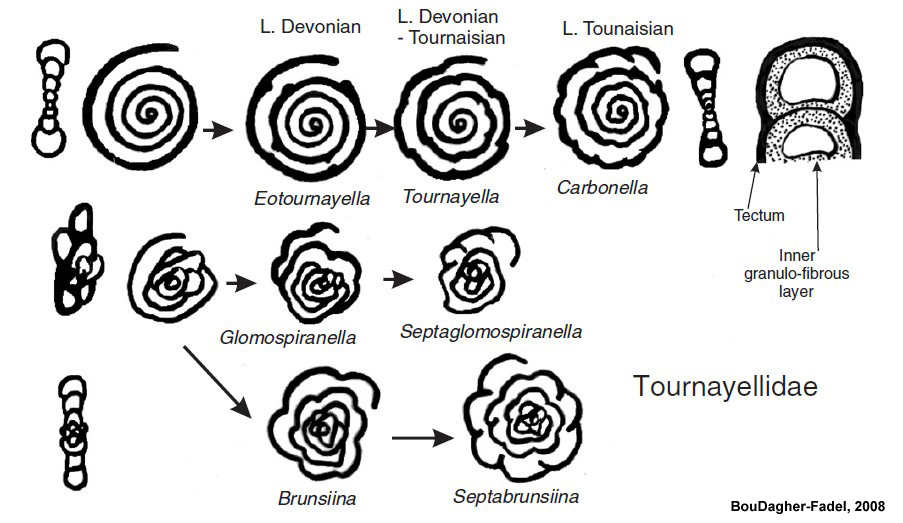
Schematic evolution of the Tournayellidae
Family Palaeospiroplectamminidae
- Test: initially streptospiral then planispiral and in later stages becomes biserial
- Geologic range: Late Devonian to Carboniferous
Superfamily ENDOTHYROIDEA
- Test: streptospiral with many chambers followed by a rectilinear stage in some forms
- Wall: microgranular and calcareous, but some forms evolved two to three distinct layers
- Geologic range: Late Devonian to Triassic
Family Endothyridae
- Test: small, multilocular, enrolled with evolute lanispiral coiling with well developed septa in early whorls or initially streptospiral to planispiral characterized by the development of secondary deposits of cacite on the chamber floor
- Aperture: low equatorial, advance forms may become uniserial with a cribrate terminal aperture
- Geologic range: Devonian to Permian
- Genera examples: Endothyra, Endothyranella, Endothyranopsis, Mikhailovella, Planoendothyra, Plectogyra, Spinoendothyra
Schematic evolution of the Endothyridae
Family Bradyinida
- Test: planispiral with few chambers
- Wall: microgranular calcareous, perforate with distinct radial lamellae with supplementary septal pores opening into the septal aperture
- Aperture: primary aperture is cribrate
- Geologic range: Carboniferous
Superfamily FUSULINOIDEA
- Test: large, varies from spherical to fusiform; the development of seondary deposits of calcite is prominent in most forms but the numerous chambers are subdivided by folds or septula
- Geologic range: Middle Devonian to Permian
There are over 100 genera recognize belonging to this superfamily. The Fusulinoidea have special morphological diagnostic characteristics that make this family unique. There are five types of wall structures that characterize the Fusulinoidea. The first four types of wall characterize the Ozawainellidae, Staffellidae and the Fusulinida. The last type of wall belong to the Schwagerinidae and Verbeekinidae. Please refer to the figure and legend below:
- Form A: two-layered walls, an inner clear fibrous light layer (early tectorium) and a dark granulous outer layer (tectum)
- Form B: Three-layered walls, the late and early tectorium surrounding the dark layer of the tectum
- Form C: Four-layered walls, wth the late and early tectorium surrounding the tectum and a glossy layer called the diaphanotheca
- Form D: Three-layered walls, where the late tecctorium disappears and they are left with the tecturm, diaphoanotheca and the early tectroium
- Form E: Composed of a tectum and a glossy layer with alveoles running through it
Five types of wall structure recognized in the Fusulinoidea
Key recognizable features of the Fusulinoidea
The Fusulinoidea was divided into eight families, based on wall structure, presence or absence of the chomata and the degree of septal folding in the test. As stated, there are over 100 genera identified. Please refer to the works of BouDagher-Fadel (2008), Loeblich and Tappan (1964; 1988), Haynes (1981) and references therein for descriptions of these important families, subfamilies and genera belonging to the Fusulinoidea.
- Family Loeblichiidae
- Family Ozawainellidae
- Family Schubertellidae
- Family Fusulinidae
- Family Schwagerinidae
- Family Staffellidae
- Family Verbeekinidae
- Family Neoshwagerinidae
Schematic diagram of the most advanced forms of fusulines
SUBORDER LAGENINA
- Test: Members of this suborder have walls that are monolamellar, with or without secondary laminations, with radiating calcite crystals which have the crystallographic c-axis perpendicular to the surface.
- Wall: Only advanced forms have secondary lamination. Reiss proposed an extensive reclassification of lamellar forms and Gronlund and Hansen (1976) proposed new terminology for lamellarity;
- atelo-monolamellar- primitive lagenines, no secondary lamellarity
- plesio-monolamellar- secondary lamellarity envolops some but not all chambers
- ortho-monolamellar- primary wall of each chamber secondarily envelops all previous chambers
- poly-monolamellar- entire test is covered by a second secondary lamella
Superfamily ROBULOIDOIDEA
- Test: typical of the Lagenina but without secondary lamellar or with slight lamination in younger taxa
- Geologic range: Late Silurian to Early Cretaceous
Family Syzraniidae
- Test: two chambered, elongate, composed of a proloculus and an undivided or subseptate tubular chamber partitioned to varying degrees by internal theickenings of the wall
- Wall: calcareous with possibly two layers
- Geologic range: Late Silurian to Late Permian
Superfamily GEINITZINOIDEA
- Test: uniserial and appear similar to the Nodosinelloidea, but the microgranular layer is the innner dark layer while the radially fibrous layer is an outer layer
- Wall: advanced forms have secondary lamellarity
- Geologic range: late Devonian to Middle Triassic
Family Geinitzinidae
- Test: free and uniserial evolving from species that are rounded in cross-section to species that are compressed with a terminal aperture
- Geologic range: Late Devonian to Late Permian
- Genera: Geinitzina. Uniserial elongate, laterally compressed test exhibiting in transverse view two planes of bilateral symmetry and an oval aperture in the center of the apertural face. Permian.
Family Pachyphloiidae
Test: free, uniserial compressed
Wall: simple calcareous microgranular but with secondary thickenings on both sides of the test
Geologic range: Permian
![]()
|
Pachyphloiidae
Test: globular proloculus followed by a uniserial succession of laterally compressed, strongly overlapping chambers
Wall: plesio or ortho-monolamellar with thin dark inner layer and thick hyaline outer layerand terminal, oval, radiate aperture
Geologic range: Early to Late Permian
|
Family Protonodosariidae
- Test: This family includes the uniserial Lagenina with atelo-monolamellar or plesio-monolamellar wall structure consisting of radial-fibrous
- Geologic range: Late Carboniferous to Late Permian
- Genera: Protonodosaria. Elongate test with horizontal straight sutures and round aperture. Late Carboniferous to Late Permian.
Family Ichtyolariidae
- Test: elongate uniserial with a single-layered wall. May show secondary lamination.
- Aperture: simple, terminal
- Geologic range: Early Permian to Early Cretaceous
Family Robuloididae
- Test: uniserial, enrolled
- Wall: atelo-monolamellar
- Aperture: terminal
- Geologic range: Late Permian
- Genera: Calvezina. Proloculous followed by five or more uniserial chambers, weakly trochospirally enrolled.The chamber is slightly compressed laterally and size increases from hemispherical to lobate. Late Permian.
SUBORDER INVOLUTININA
This suborder includes all forms with an enrolled second chamber. Walls are aragonitic but commonly recrystallized to give a homogeneous microgranular structure. They have an umbilical region with pillar-like structures on one or both sides of the test and range from Early Permian to Late Cretaceous.
Superfamily INVOLUTINOIDEA
This superfamily comprises forms consising of a proloculus followed by a planispiral to trochospiral enrolled trubular second chamber. Early Permian to Late Cretaceous. This superfamily is discussed in more detail in the following section on Triassic forams.
SUBORDER MILIOLINA
- Test: porcellaneous and imperforate, which are made of high-magnesium calcite with fine randomly oriented crystals
- Geologic range: Carboniferous to Holocene
Superfamily CORNUSPIROIDEA
- Test: free or attached and composed of a globular proloculus followed by a tubular enrolled chamber. The coiling is planispiral or trochospiral, evolute or involute.
- Aperture: simple, at the end of the tube
- Geologic range: Early Carboniferous to Holocene
Family Hemigordiidae
- Test: Trochospiral in early stages, later becoming streptospiral
- Geologic range: Carboniferous
- Genera: Hemigordius; Neohemigordius
Family Hemigordiopsidae
- Test: early streptospiral stage, later planispiral
- Geologic range: Early Carboniferous to Holocene
- Genera: Hemigodiopsis; Shanita
References
BouDagher-Fadel,
M.K., 2008. Evolution and Geological Significance of Larger
Benthic Foraminifera. Developments in Paleontology and
stratigraphy, v. 21, 540p.
Gronlund, H., Hansen, H.J., 1976.
Scanning electron microscopy of some recent and fossil nodosariid foraminifera.
Bull. Geol. Soc. Denmark 25, 121–134.
Haynes, J.R., 1981. Foraminifera. MacMillan, London,
433p.
Loeblich, A.R., Jr., Tappan, H., 1964.
Protista 2, Sarcodina, chiefly ‘‘Thecamoebians’’ and Foraminiferida. In: Moore,
R.C. (Ed.), Treatise on Invertebrate Paleontology, University of Kansas Press,
Kansas, Part C, Vols. 1 and 2.
Loeblich, A.R., Jr., Tappan, H., 1988.
Foraminiferal Genera and their Classification. Van Nostrand Reinhold, New York,
two volumes, 2047pp.
Rauser-Chernousova, D.M., Bensh, F.R., Vdovenko, M.V., Gibshman, N.B., Leven, E.Ya., Lipina, O.A., Reitlinger, E.A., Solovieva, M.N., Chedia, I.O., 1996. Guidebook on the Systematics of Foraminifers of Paleozoic. Nauka Publishing House (In Russian), Academy of Sciences of Russia.